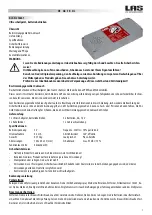
P A G E
|
1
Wintex Agro, Vilhelmsborgvej 15, DK-7700 Thisted
+45 97990800, [email protected], www.wintexagro.com
WORKSHOP MANUAL WINTEX 1000
0-25 cm
Fully automatic
Fast and efficient
Optimum speed
Minimum maintenance
Reliable
Competitive
201605


































